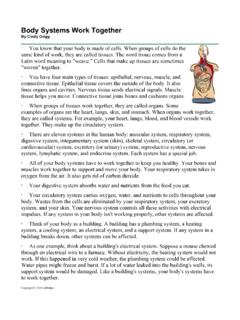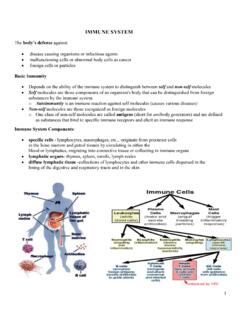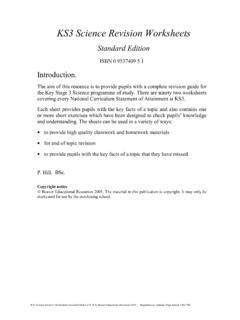Transcription of Module 10. Body Systems and Common Diseases - PHI
1 Home Health Aide Training Module 10. body Systems and Common Diseases Goal The goal of this Module is to enable participants to gain a basic understanding of how the body works, in order to better understand health, Diseases , and the role of the personal care aide in supporting the health and wellness of clients. Time 3 hours Activities Teaching Methods Time 1. body Systems Interactive presentations, large- 1 hour and group work, and small-group 30 minutes work 2. Common Diseases Interactive presentation, small- 1 hour and group work, and group 30 minutes presentations HOMECARE AIDE WORKFORCE INITIATIVE (HAWI). Trainer's Manual Page Module 10. body Systems and Common Diseases Supplies Pencils or pens Flip chart, tape, and markers (enough for each group to have one in Activity 2, Option B). Lamination equipment, if available Teaching Tools, Activity 1. body system Images (without labels) [see separate section body system Teaching Tools after this Module ].
2 Teaching Tools, Activity 1. body Systems : Common Problems Teaching Tools, Activity 2. How You Can Assist Clients Who Have Common Diseases Learner's Book 1. Introduction to body Systems 2a. The Circulatory system 2b. The Digestive system 2c. The Endocrine system 2d. The Nervous system 2e. The reproductive system 2f. The Respiratory system 2g. The Skeletomuscular system 2h. The Skin 2i. The Urinary system 3. Helping Clients with Illness 4a. Alzheimer's Disease 4b. Arthritis 4c. Cancer 4d. CVA (Stroke). 4e. Diabetes 4f. Heart Disease 4g. Lung Disease 4h. Multiple Sclerosis (MS). 4i. Parkinson's Disease HOMECARE AIDE WORKFORCE INITIATIVE (HAWI). Trainer's Manual Page Module 10. body Systems and Common Diseases Worksheets worksheet 1. Main Parts of the body Systems worksheet 2. body Systems and What They Do worksheet 3. Name That body system ! Handouts Handout 1. body Systems Handout 2. Common Diseases Advance Preparation Review all the training instructions and learner's materials for this Module .
3 Note that icons are used to remind the trainer of the following: When you are presenting or covering Key Content in the discussion. (Key Content is also addressed in the Learner's Book and the handouts, but we use the key icon only when it is covered elsewhere in the learning process.). When it is important to ask a particular question to get participants' input. When it is time to refer to the Learner's Book. When it is time to distribute a worksheet . When it is time to distribute a handout. Copy all the worksheets and STAPLE them together one set for each participant. Copy the handouts for participants. Gather all necessary supplies and equipment. Please note that the Key Content is meant to be background information for the trainer. DO NOT READ OUT LOUD TO PARTICIPANTS. HOMECARE AIDE WORKFORCE INITIATIVE (HAWI). Trainer's Manual Page Module 10. body Systems and Common Diseases Activity 1. body Systems Make sure the three worksheets have been stapled together to make one set for each participant.
4 Prepare the following flip chart pages: Learning Agenda (Step 1). Names of body Systems (Step 3). Make one copy of each full-page body system illustration in the Teaching Tools, Activity 1. body system Images (without labels) [see separate section body system Teaching Tools after this Module ]. [Or, you may laminate these illustration pages and use the same set for every training.]. Make enough copies of the urinary system illustrations, so that each group can have one page (either male or female) for the demonstration. The Teaching Tools, Activity 1. body Systems : Common Problems is not meant to be distributed for this activity. Instead, it is an optional activity for you to use if you have time left over at the end of Activity 1. (See the Teaching Tip for Step 16.). Activity 2. Common Diseases Prepare the following flip chart pages: Disease (Step 1). [Option A] Common Diseases Presentations (Step 5).
5 [Option B] Group Reports on Common Diseases (Step 5). Read the descriptions of Option A and Option B carefully, and decide which approach you will use. HOMECARE AIDE WORKFORCE INITIATIVE (HAWI). Trainer's Manual Page Module 10. body Systems and Common Diseases Activity 1. body Systems 1 hour and 30 minutes Learning Outcomes By the end of this activity, participants will be able to: Define body Systems and describe the types of body parts that make up body Systems . Identify at least six body Systems . Describe the general functions and the main parts of each system . Key Content A body system is a group of body parts that work together to perform a specific function or task. All body Systems are composed of cells, tissues, membranes, glands, and organs. body cavities are spaces within the body that are protected by the skeleton and are occupied by components of the body Systems . The major cavities are: cranial, spinal, thoracic, abdominal, and pelvic.
6 Nine body Systems are discussed in this Module : circulatory, digestive, endocrine, nervous, reproductive , respiratory, skeletomuscular, the skin (integumentary), and urinary. All the body Systems are interrelated, and they all slow down as a normal part of aging. Each system has important functions. Each also has unique problems and Diseases . Knowing the basics about how these Systems work will help the home health aide to learn, remember, and carry out his or her role in assisting clients to keep these Systems healthy and to manage the problems. HOMECARE AIDE WORKFORCE INITIATIVE (HAWI). Trainer's Manual Page Module 10. body Systems and Common Diseases Activity Steps Interactive Presentation 20 minutes 1. Introduce the Module and learning agenda. Explain that the goal is to help participants develop a basic understanding of the different body Systems and how they work. This will enable them to better understand how to keep the body working well, how Common Diseases affect the body , and how to carry out their role as home health aides in maintaining health and coping with disease.
7 Post and review the Learning Agenda flip chart page. Flip Chart LEARNING AGENDA: body Systems and Common Diseases body Systems what they do and their main parts Common Diseases What they are and how the home health aide can assist clients 2. Define body system . Explain that a body system is a group of body parts that work together to perform a specific function or task. Note that since everyone has a body , participants all probably have a lot of knowledge about the Systems of the body , whether they realize it or not! 3. Read the list of body Systems . Post and read the flip chart page with the list of body Systems . Explain that these may sound strange now, but this activity will help them see that they already know a lot about many of these Systems . Note that there are other body Systems , but these are the ones they will cover today. Teaching Tip Do not describe or explain any of these Systems ! The main purpose of this list is to help participants read and pronounce the names of each system .
8 HOMECARE AIDE WORKFORCE INITIATIVE (HAWI). Trainer's Manual Page Module 10. body Systems and Common Diseases Flip Chart Names of body Systems Circulatory system Digestive system Endocrine system Nervous system reproductive system Respiratory system Skeletomuscular system The skin Urinary system 4. Review 1. Introduction to body Systems in the Learner's Book. Ask if there are any questions before moving on to the next step. Large-Group Work 10 minutes Teaching Tips This activity uses small-group work to focus on eight of the nine Systems listed circulatory, digestive, nervous, reproductive , respiratory, skeletomuscular, the skin, and urinary with the endocrine system being covered by an interactive presentation after the group work. 5. Introduce this activity. Explain that the purpose of this activity is to introduce participants to the body Systems , through working in small groups. You will demonstrate how to do the activity by having them all work on one body system together.
9 After that they will work on the rest of the body Systems in their small groups. HOMECARE AIDE WORKFORCE INITIATIVE (HAWI). Trainer's Manual Page Module 10. body Systems and Common Diseases 6. Set up small-group work. Ask participants to close their Learner's Books and keep them closed throughout the small-group work. Split participants into groups of two or three with no more than seven groups. Distribute Worksheets 1, 2, and 3 to each participant. (They should be stapled together.). 7. Distribute sample body system image. Give each group one of the body system images for the urinary system (either male or female see Advance Preparation). DO. NOT TELL THEM WHAT system THIS IS! Ask them to note the letter in the header for this body system image H1 or H2. Explain that there are two images for this system , because the main parts look slightly different for men and for women. But every group has the same body system for this demonstration.
10 8. Demonstrate how to do worksheet 1. Explain that you all will work together on worksheet 1 to figure out which of the Main Parts descriptions best matches the colored body parts in their picture. Ask participants: Does anyone know what these body parts are called? If someone does know, then you can start reading aloud each answer on worksheet 1, until you find those body parts. If they do not know, start reading the Main Parts answers out loud and ask, after each one, if this sounds like the body parts in their pictures. Once they find the correct answer, ask them all to put the letter H in the box in front of that answer. Teaching Tip We selected the urinary system for this demonstration because we felt that participants might have a harder time identifying the main parts from this image than they would for other body system images. So you may have to help them figure out what these parts are. Use clues like asking what body part sits low in their bellies and has a tube coming out between their legs (bladder).




